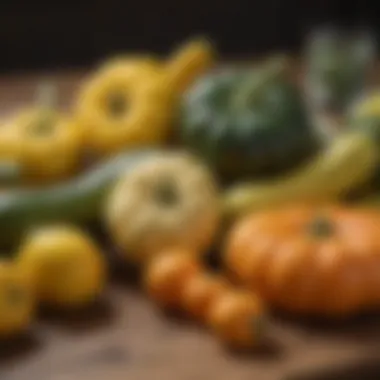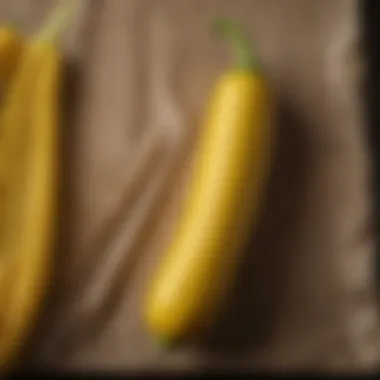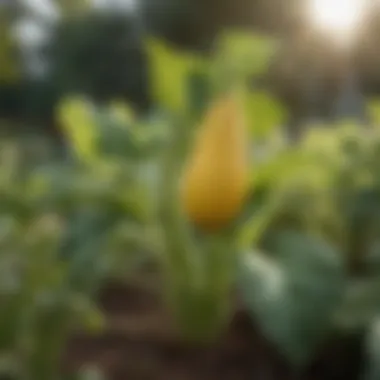Exploring the Diverse World of Summer Squash


Intro
Summer squash, with its vibrant colors and diverse shapes, stands out as one of the most versatile ingredients in the kitchen. Unlike its winter cousin, summer squash is harvested while still immature, presenting a tender texture that pleases the palate. This article dives deep into the abundant varieties of summer squash, each offering unique flavors and culinary applications. With the growing interest in healthful eating and home gardening, understanding these squash varieties can be incredibly rewarding.
While many might be familiar with standard zucchini or yellow squash, a whole world of options awaits the culinary adventurer. By the end of this piece, you will be equipped with knowledge of different types, potential recipes, and the perfect cooking techniques to make the most of this seasonal vegetable. Whether you’re planning to cultivate your own in a backyard garden or seeking inspiration for your next family meal, summer squash has a role to play.
Let’s explore this remarkable vegetable, revealing tips, tricks, and all the delights it brings to the dining table.
Preamble to Summer Squash
Summer squash, a versatile family of vegetables, is more than just a seasonal delight; it holds a prominent spot in the culinary world. Understanding its varieties and characteristics can enhance cooking experiences, leading to vibrant dishes that tantalize the senses. This exploration not only highlights flavors and textures but also addresses the health benefits of these squash types, which are packed with nutrients.
Delving into summer squash is crucial for anyone looking to diversify their palate and elevate meal preparation. Each type – from zucchini to pattypan – brings unique qualities to the table. This guide intends to cater to food lovers of all backgrounds, whether familiar with summer squash or just starting their culinary journey. By unraveling the complexities of summer squash, readers will gain confidence to experiment with various cooking methods and recipes, ultimately enriching their culinary routines.
Definition and Characteristics
Summer squash refers to a group of tender, seasonal squashes that are typically harvested while the skin is still soft and edible. Unlike their winter squash cousins, which are firm and often stored for extended periods, summer squash thrives in warm weather and is usually consumed shortly after being picked. The defining characteristics include a wide range of colors, shapes, and sizes that can create visual excitement in dishes.
Some popular traits among summer squash varieties are:
- Color Variety: Ranging from deep green zucchini to vibrant yellow squash.
- Shape Diversity: From the long and smooth form of zucchini to the whimsical, curved appearance of crookneck squash.
- Texture and Flavor: Summer squashes typically have a mild, sometimes slightly sweet flavor with a crisp texture when fresh.
This mix of appearances and tastes makes summer squash a favorite ingredient, whether raw in salads or cooked in casseroles.
Historical Context
The history of summer squash dates back thousands of years, with its origins tracing to the Americas. Native American civilizations cultivated various types of squash, integrating them into their diets. The introduction of summer squash to Europe occurred in the 16th and 17th centuries following European exploration of the New World. It soon became a staple, particularly in Mediterranean cuisine.
During the 19th century, as the culinary arts developed, different varieties were selectively bred, enhancing taste and productivity. Zucchini, for example, became popular in both Italy and the United States, especially after the rise of Italian-American dishes.
The wide-ranging cultivation methods have allowed summer squash to be included in global cuisines, making it a flexible ingredient across multiple dishes. Today, farmers grow numerous varieties suiting local tastes and climates, ensuring summer squash remains a cherished vegetable in modern culinary practices.
Types of Summer Squash
When it comes to summer squash, the diversity really packs a punch in the kitchen. This section dives into the various types, highlighting their uniqueness and culinary potential. Understanding distinct varieties not only aids in enhancing meals but also enriches the overall gardening experience for those inclined to grow their own. Different types of summer squash offer different flavors and textures, making it crucial to appreciate each one in its own right.
Zucchini
Zucchini is arguably the superstar of summer squashes. Its sleek, elongated shape and dark green skin make it visually appealing, but it’s the flavor that seals the deal. This squash’s mild taste allows it to absorb seasonings beautifully, making it versatile across numerous culinary applications. You can slice it for stir-fries, spiralize it for a gluten-free pasta alternative, or cube it for salads.
Notably, zucchini's tender texture pairs well with a variety of dishes, making it a favorite among chefs and home cooks alike. When picking zucchini, opt for smaller, firmer ones. Not only do they taste better, but they also tend to have fewer seeds.
Yellow Squash
Yellow squash comes in two main forms: straightneck and crookneck, both of which sport a bright yellow color that can brighten any dish. The straightneck variety is characterized by a smooth, slender shape, while the crookneck variety has a bent neck that adds a bit of character. Both types have a mild flavor, though the crookneck tends to be slightly sweeter.


In terms of preparation, yellow squash can be sautéed, roasted, or even stuffed. One delightful approach is to slice it thinly and layer it in a casserole with cheese and herbs, allowing the flavors to meld beautifully. Plus, it’s rich in vitamin A and potassium, providing health benefits alongside its culinary versatility.
Pattypan Squash
Pattypan squash resembles small flying saucers—funny, isn’t it? But this quirky shape isn't its only claim to fame. Available in green, yellow, or white hues, pattypan squashes are known for their tender texture and buttery flavor. Their unique shape makes them particularly eye-catching on any plate.
They can be served whole, grilled, or baked, and work well when stuffed. For a savory treat, consider filling them with a mixture of quinoa, cheese, and herbs. It’s a meal that pleases both the eyes and the palate. Additionally, their small size makes them an excellent choice for individual servings.
Crookneck Squash
As mentioned earlier, crookneck squash is a type of yellow squash, but it deserves its own spotlight. With its distinctive curved neck and warty skin, this variety stands out among its peers. The flavor is often described as slightly nutty, which makes it a delightful addition to various recipes.
Cooking crookneck squash can be straightforward: it can be steamed or mashed, adding a creamy texture to your side dishes. Alternatively, grilling brings out its natural sugars, making for a sweet, smoky side that complements meats or serves as a delightful vegetarian option.
Costata Romanesco
With a rugged appearance and a stripe pattern on its skin, Costata Romanesco is not your average zucchini. It has a richer flavor profile, often described as nutty, with a firmer texture that holds up well in cooking. This Italian heirloom variety is a favorite for those who appreciate bold flavors.
When preparing this squash, roasting or grilling works wonders. The process caramelizes its sugars, creating a deep, complex flavor that shines in salads or as a stand-alone side dish. The unique taste and texture give culinary adventurers a chance to explore new territory.
Other Notable Varieties
Beyond the mainstream options, several other types of summer squash deserve attention. These include:
- Eight Ball Squash: Round and playful, this squash is perfect for stuffing. Its shape allows for creative cooking.
- Zephyr Squash: A hybrid variety characterized by its pale green and yellow stripes, it offers a sweet flavor and firm texture.
- Luffa Squash: Often overlooked, young luffa can be eaten like zucchini, while mature ones turn into natural sponges.
In exploring these varieties, home cooks have a plethora of options to elevate their dishes, each bringing something unique to the table.
"Diversity in summer squash isn't just about color or shape; it’s about the multitude of flavors and culinary opportunities that await those willing to experiment."
Culinary Applications of Summer Squash
When it comes to summer squash, its culinary applications are nothing short of diverse. This vegetable not only adds color and vibrancy to dishes, but also brings texture and nutritional benefits that are hard to overlook. Whether you're tossing it raw in a salad or cooking it to bring out its subtle flavors, summer squash is a flexible food option that caters to a variety of culinary preferences. Understanding these applications is key to enhancing your culinary experience. It helps home cooks and seasoned chefs alike to appreciate how to make the most of this versatile ingredient.
Raw Preparations
Some people prefer to enjoy summer squash raw, and it’s easy to see why. The crisp, refreshing texture of varieties like zucchini and Yellow squash can really bright up a dish. Chopped into thin slices or julienned, they can be added to salads, lending a slight crunch that contrasts beautifully with leafy greens. You can also toss them into a fresh salsa, adding an unexpected twist alongside traditional ingredients. Not to forget, dips are a great canvas for showcasing raw summer squash. Dipping sticks of pattypan or zucchini into hummus can introduce delightful flavors as you enjoy nutrients with every bite.
Cooking Methods
Cooking methods for summer squash can transform this vegetable into something completely new, enriching dishes and allowing flavors to shine through. Below are some notable cooking methods:
Grilling
Grilling summer squash brings out its natural sweetness while providing a slightly smoky flavor. When sliced into thick planks, zucchini or yellow squash can be placed directly on the grill until they show distinct char marks. The unique feature of grilling is its ability to enhance the depth of the flavors without relying heavily on seasonings. However, it’s important to watch cooking times closely; overcooking can result in mushy texture, which is less desirable. Still, if done right, grilled summer squash can act as a fantastic side that complements any main dish.


Sautéing
Sautéing is another excellent method, as it requires minimal equipment and provides generous results in short order. When sautéed, summer squash takes on a tender but still slightly firm texture, which can be truly delightful. It’s common to pair sautéed squash with garlic and olive oil; this combination elevates the natural flavors of the squash beautifully. One notable aspect of sautéing is the ability to add other vegetables into the pan, making it a versatile option for stir-fries or hearty veggie medleys. Just keep in mind, sautéing at too high of a temperature can yield uneven cooking, which might affect the overall dish.
Roasting
Roasting summer squash offers a delightful outcome as well. When tossed in oil and roasted to a golden finish in the oven, the sugars in the squash become caramelized, resulting in a satisfying dish with rich flavors. One of the benefits of roasting includes the simplicity of the method. Just cut, coat, season, and pop them into the oven. However, be aware, if the pieces are cut too small, they may dry out. For the best results, uniform sizes are essential to promote even cooking.
Steaming
Steaming summer squash is a gentler method that helps maintain its nutrients and vibrant color. With this technique, you can bring a subtle tenderness to the vegetable without losing its crunch. This low-calorie preparation is particularly favorable for those keeping an eye on health. Steamed squash can be served as a simple side dish, drizzled with a touch of lemon and herbs for enhanced flavor. Yet one should note that steaming too long may result in losing the natural texture—there's a fine balance.
Recipes Featuring Summer Squash
The versatility of summer squash shines through in many recipes. Whether it's a zucchini pasta, a pattypan squash gratin, or a yellow squash bake, the options are limitless. By combining different cooking methods and spices, you can adapt recipes to suit your taste. Each method also impacts the flavor profile significantly, allowing you to experiment to find your preferred way to enjoy this delightful vegetable.
Nutritional Benefits of Summer Squash
Understanding the nutritional benefits of summer squash shines a light on why this versatile vegetable deserves a place in both daily diets and gourmet meals. This humble squash is not just a seasonal staple; it packs a considerable punch of vital nutrients that promote overall health. Let’s dive deeper into the key elements that make summer squash an essential ingredient in healthy cooking.
Rich in Vitamins and Minerals
When you think of vitamins, summer squash should spring to mind. This vegetable is rich in Vitamin A, which supports vision and skin health. But that’s just the tip of the iceberg. Here are some of the main vitamins and minerals you can find in summer squash:
- Vitamin C: A potent antioxidant, it helps in the maintenance of healthy skin and aids the body in fighting off infections.
- Potassium: Important for heart health, potassium helps in regulating blood pressure and balancing fluids in the body.
- Magnesium: It plays a role in over 300 enzymatic reactions, including those that produce energy and maintain muscle function.
The combination of these nutrients aids in maintaining overall health and prevents various diseases. It’s a smart choice for those looking to increase their vitamin intake without adding excessive calories. A colorful dish featuring yellow or zucchini squash can turn any meal into a nutritional powerhouse.
"Eating summer squash not only adds color to your plate but also boosts your nutrient intake substantially."
Dietary Fiber Contribution
Dietary fiber is something that a lot of people are mindful about, and obviously so. Summer squash serves as a wonderful source of fiber. Including fiber in your diet comes with several perks:
- Digestive Health: Fiber aids in better digestion and helps prevent constipation. A diet high in fiber can lead to a healthy gut and promote regular bowel movements.
- Weight Management: Foods rich in fiber help you feel full, which can prevent overeating. This makes summer squash an ideal choice for those watching their weight.
- Heart Health: Soluble fiber, found in summer squash, can help in lowering cholesterol levels, thus benefiting cardiovascular health.
Incorporating raw summer squash into salads or steaming it as a side can ensure you’re reaping these benefits.
Low Calorie Profile
For those who keep an eye on their caloric intake, summer squash is a true ally. With only about 20 calories per cup, you can consume it guilt-free. This low-calorie nature makes it suitable for various diets, whether you’re trying to manage weight or simply looking for healthier eating options. Here are some points to consider:
- Versatility: You can use summer squash in a myriad of dishes without significantly elevating calorie counts. Try spiralizing zucchini for a low-carb alternative to pasta!
- Taste: With its mild flavor, it easily absorbs the essence of whatever seasonings or ingredients it’s paired with, allowing it to fit seamlessly into various recipes.
- Nutrient Density: While it’s low in calories, summer squash is highly nutrient-dense, meaning you're getting more nutrients per calorie compared to many processed foods.
If you're exploring ways to enrich your diet, considering summer squash is an easy way to do so. Its nutritional benefits can lead to enhanced well-being, making it a fantastic addition to both everyday and special occasion meals.


Growing Summer Squash
Growing summer squash is more than just a gardening endeavor; it’s an exploration into fresh flavors and health benefits. Understanding how to successfully cultivate this vegetable can open up a world of culinary possibilities. As summer squash is known for its versatility in the kitchen, knowing how to grow it right can significantly enhance your experience with it. Also, this section will guide you through elements like the ideal conditions for planting, effective cultivation techniques, and strategies to manage pests and diseases that may affect your squash.
Ideal Growing Conditions
To cultivate summer squash successfully, certain growing conditions must be met. These squashes thrive in warm temperatures, ideally ranging from 70 to 90 degrees Fahrenheit. Here are a few crucial points to keep in mind:
- Soil Type: A well-draining loamy soil enriched with organic matter is perfect. Applying compost or well-rotted manure nurtures the plants.
- Sunlight Requirements: Summer squash needs full sun for at least six to eight hours daily. Ensure that your planting area is not overshadowed by trees or buildings.
- Water Needs: Keeping the soil consistently moist but not waterlogged is essential. Drip irrigation or soaker hoses can be highly effective in maintaining moisture without over-saturating.
These ideal conditions foster strong plant growth and yield vibrant, healthy fruit.
Cultivation Techniques
When it comes to cultivation, summer squash offers a bit of flexibility, but some tried-and-true techniques yield better results. Consider these approaches:
- Planting: You can seed directly in the ground after the last frost or start them indoors and transplant when the risk of frost has passed. Spacing is crucial; space seeds about 2 to 3 feet apart to allow for good air circulation.
- Fertilization: Applying a balanced fertilizer can promote optimal growth. A ratio such as 10-10-10 works well at planting time, with additional feedings every few weeks as the plants mature.
- Mulching: Using organic mulch, like straw or shredded leaves, can help retain moisture, suppress weeds, and keep the soil temperature stable.
With these methods, your summer squash should take off, providing you with delectable produce for the table.
Pest and Disease Management
Pests and diseases can quickly turn a gardener's dream into a headache. However, being proactive can greatly lessen such risks.
- Common Pests: Look out for squash bugs and cucumber beetles. Keeping an eye on your plants and using row covers can help keep these nuisances away.
- Diseases: Fungal diseases like powdery mildew can pose a threat from excess moisture. Adequate spacing between plants and proper air circulation helps to mitigate this risk. If you notice any plants showing stunted growth or discoloration, remove them immediately to keep the problem contained.
- Natural Remedies: If you wish to avoid chemicals, you can spray a mix of water and baking soda on affected leaves, which can help combat powdery mildew.
By mastering pest and disease management, you not only protect your crop but also contribute to a healthier garden ecosystem.
Understanding these crucial aspects of growing summer squash will not only help produce a bountiful harvest but also enrich your culinary journey with this fascinating vegetable.
Finale
In closing, the exploration of summer squash varieties provides a rich tapestry of flavors, textures, and culinary possibilities that can elevate any dish. As we’ve journeyed from understanding the basic definitions and characteristics of summer squash to delving into its nutritional benefits and optimal growing conditions, it’s clear that these vegetables are more than just seasonal offerings. They carry with them a history steeped in tradition and adaptability, reminding us of the simplicity yet complexity that nature provides in our kitchens.
Recap of Summer Squash Varieties
To recapitulate, summer squash spans a wide array of types, each offering distinct advantages:
- Zucchini: Known for its mild flavor and versatility, perfect for grilling or spiralizing into noodles.
- Yellow Squash: Its vibrant color stands out in dishes, often used in casseroles or sautéed.
- Pattypan Squash: This charming, disk-shaped variety adds visual interest and a slightly nutty taste to salads.
- Crookneck Squash: With its unique neck shape, it’s great for baking or steaming, delivering a rich flavor.
- Costata Romanesco: A ribbed Italian variety, it boasts a deeper taste, excellent when roasted.
- Other Notable Varieties: Such as white squash and gray squash, which can diversify your cooking palette, showcasing unique textures and flavors.
These varieties showcase not just their culinary applications but their potential for health benefits, offering vitamins and minerals that contribute to a balanced diet.
Encouragement for Culinary Exploration
As we conclude this guide on summer squash, it's important to encourage readers, both seasoned cooks and novices alike, to experiment with these vegetables. The kitchen is a canvas for creativity, and summer squash is an incredibly versatile ingredient that can transform simple meals into culinary delights.
Try incorporating summer squash into traditional recipes: a ratatouille, perhaps, or a refreshing salad. Or, dare to venture further into uncharted territory by creating a unique summer squash soup infused with herbs.
Embrace experimentation — don't be shy about mixing squash with unexpected ingredients. Consider adding it to a stir-fry or blending it into smoothies for an unexpected nutrient boost. The key is to keep an open mind and let your taste buds guide you.
"Cooking is not just about ingredients, but the joy of experimentation and discovery."
In essence, as you engage with summer squash, you won’t only enhance your meals; you'll find a deeper appreciation for this humble vegetable that can be anything from a simple side to the star of your plate. So go ahead, get your hands dirty in the kitchen, and experience the rich culinary landscape that summer squash has to offer!







